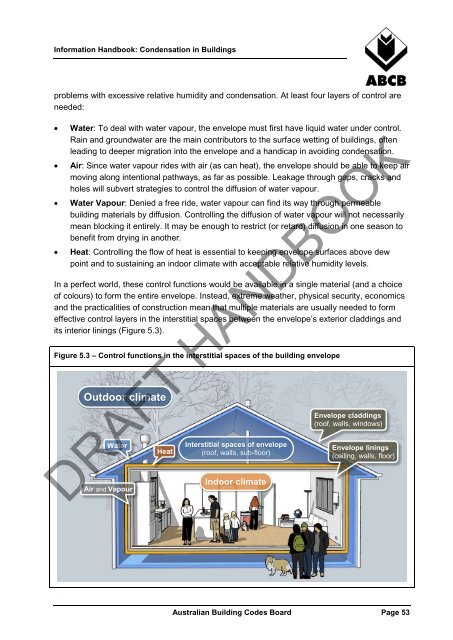Condensation in Buildings - Australian Building Codes Board
Condensation in Buildings - Australian Building Codes Board
Condensation in Buildings - Australian Building Codes Board
You also want an ePaper? Increase the reach of your titles
YUMPU automatically turns print PDFs into web optimized ePapers that Google loves.
Information Handbook: <strong>Condensation</strong> <strong>in</strong> Build<strong>in</strong>gs<br />
problems with excessive relative humidity and condensation. At least four layers of control are<br />
needed:<br />
• Water: To deal with water vapour, the envelope must first have liquid water under control.<br />
Ra<strong>in</strong> and groundwater are the ma<strong>in</strong> contributors to the surface wett<strong>in</strong>g of build<strong>in</strong>gs, often<br />
lead<strong>in</strong>g to deeper migration <strong>in</strong>to the envelope and a handicap <strong>in</strong> avoid<strong>in</strong>g condensation.<br />
• Air: S<strong>in</strong>ce water vapour rides with air (as can heat), the envelope should be able to keep air<br />
mov<strong>in</strong>g along <strong>in</strong>tentional pathways, as far as possible. Leakage through gaps, cracks and<br />
holes will subvert strategies to control the diffusion of water vapour.<br />
• Water Vapour: Denied a free ride, water vapour can f<strong>in</strong>d its way through permeable<br />
build<strong>in</strong>g materials by diffusion. Controll<strong>in</strong>g the diffusion of water vapour will not necessarily<br />
mean block<strong>in</strong>g it entirely. It may be enough to restrict (or retard) diffusion <strong>in</strong> one season to<br />
benefit from dry<strong>in</strong>g <strong>in</strong> another.<br />
• Heat: Controll<strong>in</strong>g the flow of heat is essential to keep<strong>in</strong>g envelope surfaces above dew<br />
po<strong>in</strong>t and to susta<strong>in</strong><strong>in</strong>g an <strong>in</strong>door climate with acceptable relative humidity levels.<br />
In a perfect world, these control functions would be available <strong>in</strong> a s<strong>in</strong>gle material (and a choice<br />
of colours) to form the entire envelope. Instead, extreme weather, physical security, economics<br />
and the practicalities of construction mean that multiple materials are usually needed to form<br />
effective control layers <strong>in</strong> the <strong>in</strong>terstitial spaces between the envelope’s exterior cladd<strong>in</strong>gs and<br />
its <strong>in</strong>terior l<strong>in</strong><strong>in</strong>gs (Figure 5.3).<br />
Figure 5.3 – Control functions <strong>in</strong> the <strong>in</strong>terstitial spaces of the build<strong>in</strong>g envelope<br />
Outdoor climate<br />
Water<br />
Air and Vapour<br />
Heat<br />
Interstitial spaces of envelope<br />
(roof, walls, sub-floor)<br />
Indoor climate<br />
Envelope cladd<strong>in</strong>gs<br />
(roof, walls, w<strong>in</strong>dows)<br />
Envelope l<strong>in</strong><strong>in</strong>gs<br />
(ceil<strong>in</strong>g, walls, floor)<br />
DRAFT HANDBOOK<br />
<strong>Australian</strong> Build<strong>in</strong>g <strong>Codes</strong> <strong>Board</strong> Page 53
















